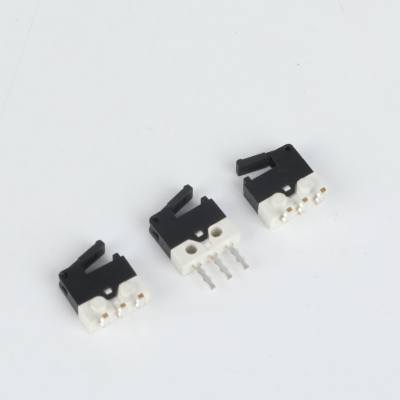Exploring Micro Switches: Small but Mighty Components in Modern Electronics
2025-01-04
In the world of electronics, small components often play an outsized role in ensuring efficiency, safety, and functionality. One such unsung hero is the micro switch. Despite its compact size, the micro switch is an incredibly versatile and reliable component used in a wide range of applications, from home appliances to industrial machines.
In this blog, we’ll take a deep dive into what a micro switch is, how it works, its various applications, and why it’s a critical component in many modern electronic systems.
What is a Micro Switch?
A micro switch, also known as a snap-action switch, is a type of electrical switch that is activated by a very small physical movement. Unlike traditional switches that may require larger physical motion to open or close a circuit, micro switches require minimal mechanical force to activate, thanks to their sensitive mechanism.
Micro switches are typically made up of a metal lever and a spring-loaded actuator. When a specific force is applied to the actuator, the switch “snaps” into position, either opening or closing an electrical circuit. This action happens very quickly and reliably, making micro switches ideal for applications that require precise control and response.
How Does a Micro Switch Work?
Micro switches operate using a snap-action mechanism, which is a critical feature that allows them to function effectively with very minimal physical movement. Here's a simplified explanation of how the mechanism works:
1. Actuator Pressed: When an external force or pressure is applied to the actuator (such as a button, lever, or pin), it causes the mechanism inside the switch to move.
2. Snap Action: This motion triggers the snap-action mechanism, where the internal contacts quickly "snap" into place. The internal metal contacts either open or close the circuit depending on the switch's configuration.
3. Circuit Change: Once the contacts are in place, the electrical circuit is either completed (closed) or interrupted (open), depending on the function of the switch.
4. Return to Neutral: After the force is removed from the actuator, the switch typically returns to its neutral position due to the spring mechanism, ready for the next activation.
Types of Micro Switches
Micro switches come in various types, designed for different applications and environments. Some common types include:
1. Basic Micro Switches
These are the standard micro switches used in a variety of general-purpose applications. They feature a simple actuator (like a lever or roller) and are available in different sizes and electrical ratings.
2. Waterproof Micro Switches
These micro switches are designed for environments where exposure to water or moisture is likely. They feature sealed enclosures that protect the internal mechanism from water and other contaminants.
3. Heavy-Duty Micro Switches
Heavy-duty micro switches are built for applications that require higher durability, such as industrial machinery, automotive systems, and large appliances. These switches are designed to withstand high mechanical stress and electrical load.
4. Subminiature Micro Switches
As the name suggests, subminiature micro switches are extremely compact versions of the standard micro switch. These are ideal for applications where space is limited, such as in medical devices, consumer electronics, and compact machinery.
5. Limit Switches
A type of micro switch often used in machinery, limit switches detect the position of a moving part. They can stop the movement or activate a safety mechanism when a machine part reaches a certain point.
Benefits of Micro Switches
Micro switches offer numerous advantages that make them indispensable in many industries. Some of the key benefits include:
1. High Precision
Micro switches are known for their precise operation. The snap-action mechanism ensures that the switch reliably and consistently opens or closes the circuit with minimal movement, making them ideal for applications where accuracy is paramount.
2. Long Lifespan
Because micro switches are designed to handle millions of cycles, they have an impressively long operational life. The spring-loaded mechanism is durable, and the contacts are designed to withstand frequent use without degradation.
3. Compact Size
One of the most significant advantages of micro switches is their small size. Despite their tiny form, they pack a lot of functionality into a small package, making them perfect for applications where space is at a premium.
4. Fast Response Time
Micro switches have extremely quick response times, making them highly effective in systems that require rapid activation or deactivation. This quick "snap" action ensures that the system responds immediately when the switch is triggered.
5. Reliability
Micro switches are highly reliable, even in demanding environments. They are built to handle vibrations, shocks, and a wide range of temperatures, making them suitable for both consumer and industrial applications.
6. Variety of Options
Micro switches come in various configurations to suit different needs, including different actuators (e.g., levers, rollers, buttons) and electrical ratings. This versatility ensures that micro switches can be adapted to many different types of equipment and environments.
Applications of Micro Switches
Micro switches are used in an array of applications across different industries, owing to their precision, reliability, and versatility. Here are some of the most common uses:
1. Home Appliances
Micro switches are frequently found in household devices like refrigerators, washing machines, ovens, and dishwashers. For example, they can be used in door latches (e.g., in microwaves or washing machines) to ensure the door is securely closed before the appliance can operate.
2. Automobiles
In the automotive industry, micro switches are used in a variety of systems. They can be found in seatbelt mechanisms, door sensors, ignition systems, and safety features like airbags. Their compact design and reliability are well-suited for the harsh conditions in vehicles.
3. Industrial Equipment
Micro switches play a crucial role in industrial machinery, including conveyor belts, robotic arms, and other automated systems. They are often used as limit switches to detect the position of moving parts or as safety interlocks in high-risk areas.
4. Elevators
Elevator systems rely on micro switches to control door open/close mechanisms, floor selection buttons, and safety features such as overload detection. The precise activation of these switches is critical to the safe operation of the elevator.
5. Medical Devices
In medical equipment, such as infusion pumps, patient monitoring systems, and diagnostic machines, micro switches are used for safety and control. Their small size and accuracy make them perfect for applications where space is limited but reliability is critical.
6. Consumer Electronics
Micro switches are often found in everyday consumer electronics, such as remote controls, game controllers, and mobile devices. They help detect button presses, ensure proper connections, and trigger specific functions within the device.
7. Security Systems
Micro switches are integral to security systems like burglar alarms and access control mechanisms. They are used to detect the opening of windows or doors or to trigger a security alarm when a motion sensor is activated.
Conclusion
Although small in size, micro switches are an essential component in modern electronics, playing a key role in ensuring the safety, precision, and functionality of a wide variety of devices. From household appliances and industrial machines to medical equipment and automotive systems, micro switches are relied upon for their fast response, durability, and reliable performance.
As technology continues to evolve, the role of micro switches will only become more critical. Their compact size, precision, and reliability make them an indispensable part of modern systems, and they will undoubtedly remain a core component in countless applications for years to come. Whether you're designing a new product or troubleshooting an existing one, understanding the importance of micro switches will help ensure the longevity and performance of your systems.



